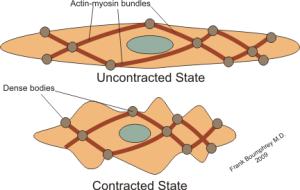9.5: Overview of Muscle Functions
- Page ID
- 39022
The function of muscles is movement, but the types of movement elicited differ between skeletal, cardiac, and smooth muscle.
LEARNING OBJECTIVE
By the end of this section, you will be able to:
- Differentiate among the actions of skeletal, smooth, and cardiac muscles
Key Takeaways
Key Points
- The origin and insertion points of skeletal muscles allow force to be exerted that allows movement of the skeleton.
- Skeletal movement is a form of lever mechanics with the position of origin and insertion of the muscle allowing for differences in force, velocity, and directionality.
- Smooth muscles act by involuntary peristalsis, moving food through the digestive system.
- Cardiac muscle contracts the heart without conscious thought, which is necessary for survival.
Key Terms
peristalsis: The rhythmic, wave-like contraction of both longitudinal and circular smooth muscle fibers within the digestive tract that forces food through it.
insertion: The distal end of attachment of a muscle to a bone that will be moved by the muscle when it contracts.
origin: The proximal end of attachment of a muscle to a bone that will not be moved by the action of that muscle.
Examples
- While cardiac muscle is considered involuntary, some individuals with yogic training have been shown to be able to voluntarily reduce their heart rate.
- Food poisoning can result in involuntary reversed peristalsis or vomiting.
Skeletal muscles are voluntary, striated muscles that allow movement of an organism by the deliberate generation of force . The action a skeletal muscle generates is determined by the origin and insertion locations. The cross-sectional area of a muscle (rather than volume or length) determines the amount of force it can generate by defining the number of sarcomeres which can operate in parallel. The amount of force applied to the external environment is determined by lever mechanics, specifically the ratio of in lever to out lever. For example, moving the insertion point of the biceps more distally on the radius (farther from the joint of rotation) would increase the force generated during flexion (and, as a result, the maximum weight lifted in this movement), but decrease the maximum speed of flexion. Moving the insertion point proximally (closer to the joint of rotation) would result in decreased force but increased velocity. This can be most easily seen by comparing the limb of a mole to a horse: In the former, the insertion point is positioned to maximize force (for digging), while in the latter, the insertion point is positioned to maximize speed (for running).

In addition to voluntary contractions of skeletal muscle, involuntary muscle also contracts in a similar fashion but does so involuntarily. Smooth muscle is responsible for movement of food through the digestive system via peristalsis and regulates the diameter of blood vessels, determining how much blood flows through the vessels. Cardiac muscle is responsible for contraction of the heart . The contraction of cardiac muscle of the heart is coordinated such that the entire heart beats in a controlled, uniform manner, ensuring blood is efficiently pumped from the chambers. Cardiac and smooth muscle contraction occurs without conscious thought and is necessary for survival.
- Overview of Muscle Functions. Provided by: Boundless. Located at: https://courses.lumenlearning.com/boundless-ap/. Project: Boundless Anatomy and Physiology. License: CC BY-SA: Attribution-ShareAlike
- Lifetime Fitness and Wellness. Provided by: Extended Learning Institute of Northern Virginia Community College. Located at: https://eli.nvcc.edu/. License: CC BY: Attribution



